With their sleek coat and proud appearance, the Doberman Pinscher is arguably one of the most regal-looking dogs in the world. Loved as a family companion but often regarded solely as a guard dog by those who don’t truly understand the breed, Doberman Pinschers are one of the most misconstrued dog breeds. The good news, however, is that we’re here to dispel any myths and give you all the dog breed information you could ever want, below. So keep reading to discover everything about the Doberman Pinscher.
Breed Overview
- Dog Breed Group: Working Dog
- Height: 24- 28 inches at the shoulder
- Weight: 60-80 pounds
- Life Expectancy: 10 – 13 years
This is a dog breed that was created for function, rather than form, and as such host a wide variety of positive traits, alongside their use as a guard dog. Doberman Pinschers are extremely agile, brave, smart and quick in both physical and mental capabilities. Because of these very traits, however, they can also be rather headstrong and require a knowledgeable pack leader to counteract the Doberman breed reputation.
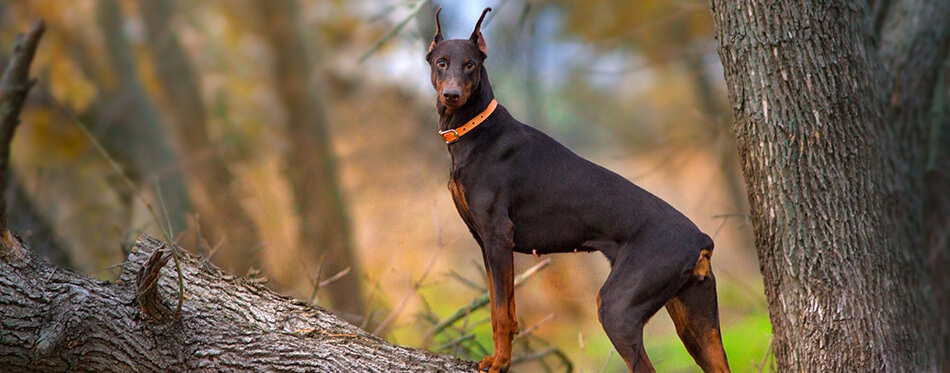
Short History of the Dobie Dogs
Also referred to as a Dobie, and spelt Dobermann in many other countries, the Doberman Pinscher is a relatively new dog, when compared to most other breeds. They were bred in the late 19th century, by the German man Karl Friedrich Louis Dobermann, who was rather secretive about the breed selection he used to create this fierce and formidable dog breed. However, it is believed that the genetic makeup of the Doberman Pinscher includes the Rottweiler, German Pinscher and Terrier.
Later, the breed was finessed by Otto Goeller into becoming more of a family member that could also be harnessed in a wide range of canine sports, rather than simply being used as guard dogs. Thus, in the early 1900’s, the Doberman was recognized by the German Kennel Club before being brought over to the United States.
In 1921, the Doberman Pinscher Club of America was founded, which adopted the breed standard from Germany. However, due to both the First and Second World War, the breed declined dramatically – particularly in Europe. Bigger dogs were more expensive to feed and so the breed was owned solely by those who could get professional use out of their Doberman Pinscher.
Because they were owned by the military, police and very wealthy people during this time, the breed became known for their protective nature and use as guard dogs. As well as this, it is possible that without being bred in America, it is very likely that the Doberman Pinscher dog breed would be extremely rare, today.
These days, the Dobermann is utilized as far more than just a police dog. With years of breeding, and breeders showing particular interest in their use in dog sports, as well as for their high energy (making them an ideal dog breed for search and rescue missions), this dog breed has become much more friendly over time. Thus, the Doberman Pinscher is now also treated as a beloved family pet, and the breed is even used as therapy dogs or as a show dog in events.
Who was Karl Freidrich Louis Dobermann?
Karl Friedrich Louis Dobermann – sometimes simply referred to as Louis Dobermann – was the original breeder of the Doberman Pinscher. Dobermann lived as a tax collector and dog collector and therefore required a dog that could act as both a protector and loyal follower. He wanted a protection dog that could happily follow orders and comply with obedience training, while also having an excellent life span and a high level of exercise tolerance.
Due to his access to so many different dog breeds, Dobermann was able to create a new breed of dog that would suit his needs exactly. However this was not a dog that was initially bred to become a family pet, and this is one of the reasons why the breed works so well as military dogs or as a police dog is due to their desire to guard and protect.
Luckily, the Doberman Pinscher is now used in a wide variety of different contexts, from being shown in the arena at events, through to dog sports such as agility, or simply being excellent family pets. These days, the Doberman Pinscher has a tendency to be misunderstood and they have even become a bit of a couch potato!
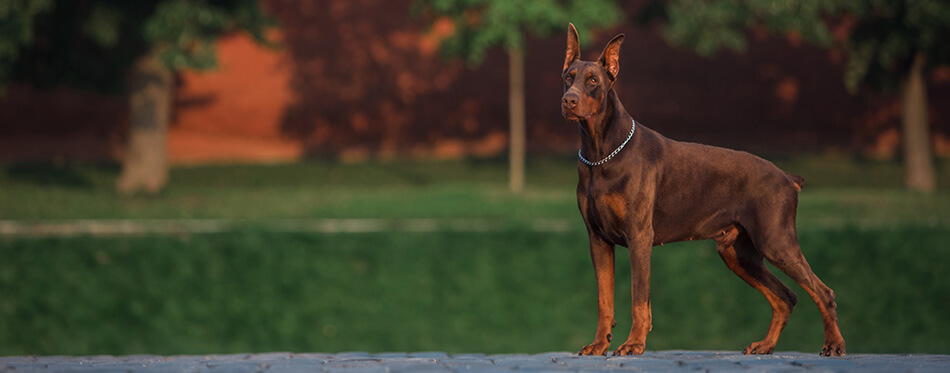
Breed Facts
- The height of your Doberman can vary, depending on which gender you bring home. Males have an average height of around 26- 28 inches, while females stand at around 24 – 26 inches.
- Dobermans are not a good choice for allergy sufferers and are not hypoallergenic.
- Their docked tails and erect ears are a result of owners wanting their dogs to be ready for a fight – and therefore wanting to remove any “weak spots”.
- The Doberman was the first breed of dog to be killed in the 1944 Battle of Guam. As such, there is a statue of a Doberman Pinscher in the United States Marine Corps War Dog Cemetery, Guam.
- The Doberman Pinscher breed are becoming more docile, the older the breed becomes, as owners move away from aggressive traits being bred.
- They are considered the 5th smartest dog breed.
- Doberman Pinschers are originally from Germany.
- Dobermans often refuse to go out in the rain, and tend to hate swimming.
- The Dobermann is the 14th most popular breed in the United States.
- They are well-known for ignoring their owners, if they do not want to do what is being asked of them.
- Despite having high energy levels, this dog can easily become a lap dog and spend all of their time curled up with their owner if they aren’t encouraged to go outside.
- The Doberman Pinscher dog breed is often described as being a Velcro dog, as they always want to be near their owners.
What Do Doberman Pinschers Look Like?
The Doberman Pinscher is a medium-sized dog that has a highly muscular frame. The breed standards offered by the American Kennel Club suggest that Dobermans should be “Compactly built, muscular and powerful, for great endurance and speed”. Indeed, this dog breed tends to drive their power from their rear, and their gait proves to be strong and firm, with their hindquarters doing most of the work.
They have a well-proportioned body, with their neck widening toward their muscular shoulders and having a firm, proud appearance. Some Doberman Pinschers will have their tails docked – though this practice is luckily falling out of fashion – while others have a long tail that may curl over the back. Their chest is broad, and extremely muscular, while their stomach tucks upwards to suggest an active, athletic look. This – combined with their overall muscular frame – gives them a powerful appearance in line with the “family protector” role.
Their fur is short, lying close to their body, and, when well-groomed, have an incredibly shiny, almost glowing appearance that showcases their health and wellbeing. The coat itself can come in a wide range of colors, including fawn, red/rust and black. However, their most common coloring is the black and tan coat which is the most well-known and likely to be the coat color that spring to mind, when discussing the breed.
One of the most rare color types that can be found in the Doberman dog breed is due to the albino gene. The albino gene causes the dog to lack any melanin production, meaning there is no color pigment across the entire body. It is generally advised by the Doberman Pinscher Club of America and Kennel Clubs across the world that purposefully breeding Doberman Pinschers with the albino gene should not be considered, due to the high risk of health problems that come with the genetic mutation.
The Doberman Pinscher’s most recognizable feature, however, is their head and face. Their almond-shaped eyes are always alert, and deep-set in their head, which is of a long, triangular shape. Some Doberman Pinscher pets may have larger, floppy ears, and – unfortunately – these are not considered a part of the breed standard. Instead, the ears must be erect and stand proudly atop the head. This gives them the look akin to Anubis, of Egyptian myth, despite the fact that the Doberman is actually a much younger breed!
Doberman Temperament
Incredibly intelligent and – at times – slightly hyperactive, Doberman Pinscher dog breeds have a temperament that holds touch of everything we love about dogs in them. Dobermans have a tendency to act a little like puppies, but their height and weight will usually ensure that their bumbling can lead to items around the home getting whipped off by their tail, if the owners haven’t docked it.
Their naturally fun-loving nature and high level of intelligence means that Doberman puppies will need to be well-socialized from a young age, as well as being given plenty of physical and mental stimulation to keep their energy level low. Doberman Pinscher dog breeds can be easily trained and their eagerness to please their family will make your Pinscher a great companion over their long life span.
You should be willing to spend a lot of time with this dog breed, and prepared to help fulfill their exercise requirements with a lot of walks and playtime. The Doberman personality demands a lot of attention, socialization, and training, whether you’re looking to use your Pinscher breed as a show dog or keep them as a family pet.
Taking the time to train your Doberman as a puppy will ensure that they grow up to become the ideal companion as they grow into an adult dog. Do bear in mind, however, that they often aren’t aware of their height – even as they become fully grown adult dogs – and therefore can be a little clumsy around smaller children. For this reason, we would usually recommend them being in an adult-only household, purely because they’re prone to knocking over smaller children or being a little too haphazard with their play.
The best way to raise a happy, healthy and well-trained Doberman Pinscher is to provide them with plenty of exposure. By taking your Doberman for a walk in a wide variety of different areas and getting them used to being around lots of other dogs and people, you’ll help to create a dog that not only has a healthy immune system and body, but they’ll be a great family pet too.
Do Doberman Pinschers Bark a Lot?
Dobermans are a protective dog breed by their nature and can be prone to barking when they feel that their home space is being invaded – even if it’s just by a passer-by. The best way to avoid problems with their vocal habits is to use plenty of positive reinforcement, to ensure they don’t cause any hassle with the neighbors or give you a headache. Being so eager to please and easy to train, you’ll be surprised how quickly your dog picks up commands, so this shouldn’t cause too much disruption in your life.
How Do you Keep Them Entertained?
The Doberman Pinscher is an incredibly intelligent breed that needs plenty of exercise. The best way to keep this dog breed entertained is to put them to work! With a muscular body and slim size, these dogs are tailor-made for agility or similar events that puts their energy level to good use. Be sure not to start this at too young an age, as too much exercise at a young age can cause your pets to develop joint problems. After the first year, however, their body should be developed enough for your pets to enjoy various dog sports.
For keeping your Doberman Pinscher entertained while you’re at work, however, you may need to get a little more creative. Dogs love to chew, so choosing a great set of dog toys that can withstand their desire to chew is a must. Products such as antlers or yak’s milk treats are a great choice, and dog toys that encourage problem solving are a great choice for Dobermans, too.
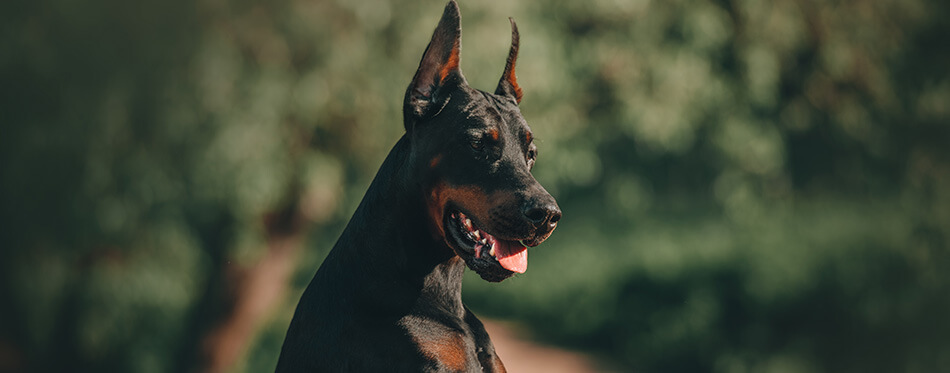
Are Dobermans Aggressive?
Despite their reputation, a Doberman dog is usually not aggressive. Unfortunately, however, if your dog becomes bored or restless – or has not been well trained or socialized – the Doberman can become aggressive. They can also show some aggressive tendencies toward strangers, despite being very loving and loyal to their owners. For this reason, it is essential that your pet is introduced to many different sights, sounds and experiences as possible, to create the ideal temperament for your Doberman Pinscher.
Is the Doberman Pinscher a good family dog?
Protective and loving, there is no reason that a well-trained Doberman Pinscher can’t be a good family member. While this dog breed may be a little clumsy at times, and require ample training, Dobermans are generally very sweet and soft toward their owners. For households with younger family members, it is generally advised that your dogs are brought home from a young age, as this will encourage them to fit in with your lifestyle, rather than you fitting in with theirs.
Are They Easy to Potty Train?
Thanks to their incredible intelligence, Dobermans are extremely easy to house train. If you have concerns about potty training your pet, it can be worth checking out tips to help you along, including crate training. As long as you’re prepared to jump up and let out your dogs while training, as soon as they request to go outside, then it shouldn’t take too long for your pet to understand that they need to pee and poop outside!
Doberman Pinscher Care
As with all dogs, understanding how to care for your Dobermans can make the difference between a happy household and a chaotic one. Bringing home any pet can be a daunting experience, but dogs are especially sensitive to care as they are so intrinsically tied to their masters. If you are looking to bring home active and clever breeds, this can be multiplied endlessly. The good news, of course, is that understanding Pinschers ensures you’re able to care for the breed and create a healthy space for everyone.
Are they Healthy?
Generally speaking, Dobermans are a healthy breed. This could be due to their wide genetic lineage provided by the initial breeders, or simply because they are usually brought home by those who are experienced dog owners. Nevertheless, it’s important to understand that all dogs have genetic predispositions to health conditions, and Pinschers are no different. Below are some of the most common health conditions you can find in your Doberman Pinscher pet.
Gastric Dilatation Volvulus
Common in any dogs with larger jaws, Gastric Dilatation Volvulus (GDC) is caused by dogs eating too much, too quickly. What may start as canine bloat can often lead to GDC, and if you suspect this illness, it is vital that you call your vet immediately, as this can be fatal.
It is caused by the stomach dilating, due to an excess of food and/air that has made its way into the gastric system. It is one of the most common health problems found in dogs, and can cause a range of problems from placing too much pressure on the diaphragm, to the prevention of adequate blood flow around the body.
The most common way of noticing GDV is if your usually athletic dog looks as though they have suddenly put on weight, due to the distention of the stomach area. You may also notice your dog retching, without producing anything, or a sudden change in behavior.
Von Willebrand’s Disease
Von Willebrand’s Disease can be found in both dogs and humans, affecting your pets in the same way as hemophilia. Unlike hemophilia, however, Von Willebrand’s Disease can affect males and females equally, while still being genetically transmitted from parents to puppies. For this reason, it is important to ask breeders whether Doberman parents have been screened for these health concerns.
It develops as a blood-based protein deficiency – specifically the protein designed to help wounds to clot and therefore heal. Unfortunately, this means that those with Von Willebrand’s are much more likely to suffer with excess blood loss after a cut or surgery. They will also take longer to heal from bruising.
If you notice blood in your dogs’ feces, spontaneous nose bleeds, blood in the urine or across your pets’ jaws and gums, this may be a sign that your pet has this health concern. You might also notice your dog becoming lethargic, due to losing excess blood while in heat or suffering from anemia.
Wobbler’s Syndrome
Also referred to as the “canine wobbles”, Wobbler’s Syndrome can be found in many different dogs of all breeds and backgrounds but does affect Pinschers more than others. It is actually caused by cervical vertebral instability (the spine moves with an extended range of motion) which, in turn, affects the intervertebral discs (the areas between the bones of the spine) and the caudal cervical vertebrae (toward the tail).
Over time, this then develops into myelopathy, which is damage to the spine caused by intense compression. Naturally, this can become extremely painful for your dog, and symptoms can start from the age of two years and up – another good reason to ensure that your breeders only breed pets from over the age of two.
Signs of these health concerns include your dog struggling to stand up, hanging their head low (in order to relieve pain from the compression), walking with a wobbly gait (hence the name), and struggling when walking slowly or over a slippery floor.
Eye Problems
Eye problems are common across the life span of a range of different dog breeds, and usually develop toward the later end of your dogs’ life. Eye diseases that are common in Doberman Pinschers include progressive retinal atrophy (PRA), retinal dysplasia, cataracts, entropion, and cherry eye.
If you notice your dog is pawing at their head and face a lot, these can usually be signs of both entropion and cherry eye, and owners will need a call to the vet as soon as possible. If left untreated, they can cause blindness and both entropion disease and prolapsed eye disease (cherry eye) require surgery to rectify.
Heart Disease
Heart disease usually occurs toward the end of the life span in most dogs, due to the wear and tear created through a full life of work! Dobermans, however, seem to suffer from one particular form of heart disease over other types. Dilated cardiomyopathy is a disease that causes the heart chambers to become weaker over time, leading to inefficient amounts of blood pumping through the body of your pet.
When left untreated, dilated cardiomyopathy can lead to heart failure and organ failure. There is also an increased risk of blood leaking back through the chambers. Unfortunately, there are few signs and symptoms of this disease until the dogs’ cardiomyopathy is quite pronounced. However, keeping your dogs well-exercised and providing ample physical stimulation can help keep your dogs’ heart strong for years to come.
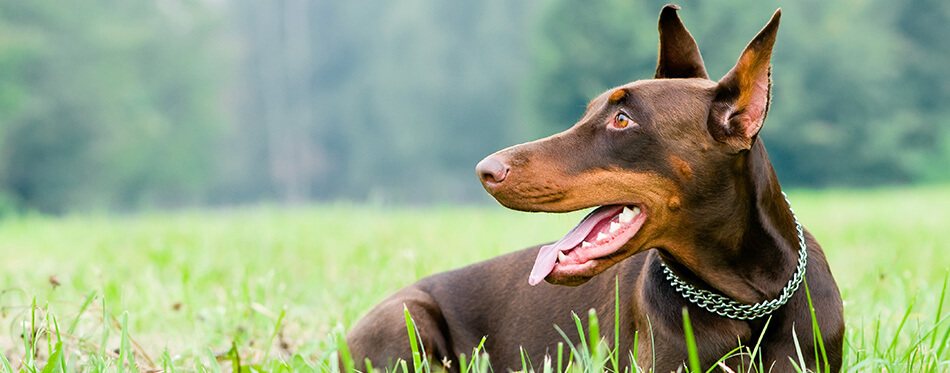
Hypothyroidism
Another good reason to keep an eye on your dogs’ weight is due to health concerns that can arise from weight gain. However, with some breeds, weight gain can actually be a symptom of hypothyroidism. This happens when the thyroid gland does not produce enough thyroxine – a hormone responsible for nutrients in the food being processed correctly – and therefore food is not digested properly.
Signs of hypothyroidism include a poor quality coat, dry skin, and lethargy. The good news, however, is that this illness can easily be remedied through regular medication.
How Long do They Live?
Doberman Pinschers, on average, can live up to 13 years. With a good diet and lots of exercise, however, they may surprise you by living longer than this!
Are They Easy to Train?
Dobermans are one of the most intelligent breeds and are therefore incredibly easy to train. As long as they have burned off any excess energy and you’re both speaking the same language (dog training is about humans learning how to speak to their dogs, after all), you’ll find your pet is extremely eager to please and therefore easy to train.
How Much Exercise does a Doberman Need?
The exercise requirements of this breed are especially high, and your pet will need plenty of walks and play in order to meet their needs. Do be aware that puppies should be given lots of shorter walks, so as not to put too much of a strain on their joints, while fully grown pet pals will enjoy as much exercise as you can give them!
What and How Much Should you Feed a Dobie Dog?
Dobermans require food that is easily palatable and easy to digest. The best Doberman dog food will include a high-quality meat source such as chicken, with lots of protein to help keep the muscular body of the Doberman healthy. Brown rice or sweet potatoes are also an excellent source of healthy carbs for your dog, so these should ideally be second on the ingredients list.
Do be aware that Dobies can eat a little too quickly, and you may wish to use some tips and tricks to help discourage your dog from eating too fast, in order to avoid bloat and GDV.
How Much to Feed a Doberman Puppy
A Doberman puppy should only have around half a cup of high-quality dog food, once in the morning, at noon, and at night. As they grow older, you can increase this gradually until they are having between two and five cups of food, per day. Keep an eye on the weight of your pet as you feed them, and scale back portions if they appear to be gaining too much.
Check out: Dog Food for Dobermans
Do they Shed a Lot?
Dobermans do shed a lot. However, as their coat is so short and close to the body, you might not notice this as much as you would with long-haired dogs. A great way to reduce the amount of hair you find around the house is to regularly groom your Pinscher.
How do You Groom a Doberman?
The best way to care for your Doberman’s coat is to groom your pet regularly. While their grooming needs are very low compared to some other breeds who need daily care, a once-over with a grooming mitt will usually be enough to help remove any loose hairs and keep your house clean.
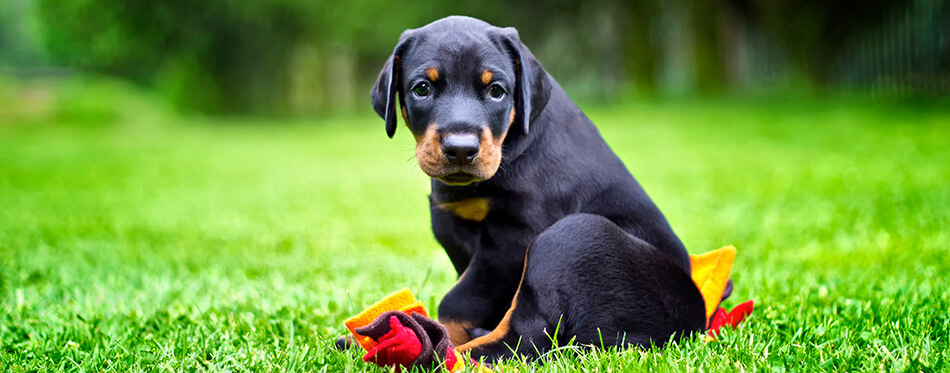
How to Find a Good Breeder
The key to any good breeder is their reputation. Ethical breeding should always work to have any genetic health issues bred out of the family, and you should always be able to meet both parents and be confident in the level of care that they are provided with. Regardless of the size of the business you purchase from, the care of their puppies should be at the forefront of everything they do, and they should be able to answer any questions you may have about your new Doberman or their parents.
Adopt a Dog From a Rescue Center or Shelter!
We would always recommend checking our the local rescues to find your next pet pal. As always, be sure to ask as many questions as you need, before adopting your Doberman Pinscher, so you can be sure they’re the right pet for you.
While many may worry that getting their Doberman from rescues may increase the risk of getting an aggressive dog, it’s always worth considering that dogs can be trained at any age. As such, you might find your new best friend in a rescue center!
What is the Average Price for a Doberman Pinscher?
The average price of an AKC registered Doberman Pinscher can range from $800 to $1200, though some breeders may charge more than this if they have puppies from a particularly impressive lineage. Meanwhile, most rescues will have their own adoption fees that cover their basic costs and therefore prices will be much lower.

